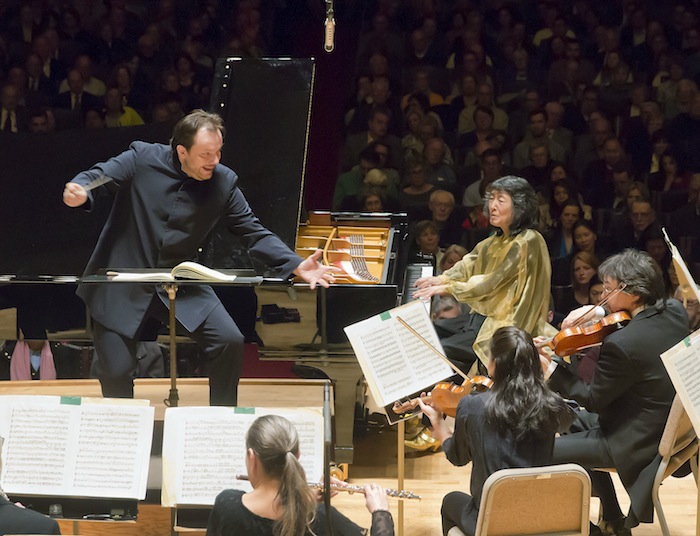Nelsons, BSO reach the summit with Bruckner’s Sixth

Mitsuko Uchida performed Mozart’s Piano Concerto No. 20 with Andris Nelsons and the Boston Symphony Orchestra Thursday night at Symphony Hall. Photo: Winslow Townson
The Andris Nelsons era with the Boston Symphony orchestra has brought new attention to works left unexplored by previous music directors. The current survey of Shostakovich’s symphonies, which will continue into next season, has been particularly rewarding, with its recordings landing the BSO and its 38-year-old conductor back-to-back Grammy awards.
The music of Bruckner will be another focus for the Latvian conductor next season when Nelsons leads the composer’s Fourth Symphony as part of a multi-year exploration of the Austrian composer. The survey got an early start Thursday night at Symphony Hall, where the conductor led a powerful account of Bruckner’s Symphony No. 6.
Completed in 1881,the Sixth remains one of the composer’s least-performed creations. It’s hard to see why. The orchestration is clear and vivid, with chamber-like intimacy woven into its sprawling, hour-long structure. Its earthy themes reveal the composer’s characteristic style. Brass figures, too, sound boldly from the depths. In all, the work ranks with the better known Seventh, Eighth, and Ninth Symphonies, and is just as much a “cathedral in sound.”
Nelsons’ approach reveled in the details of the score, and Bruckner’s work served as a broad symphonic canvas on which the conductor worked. The resulting music was woven from layers of repetitive material. Dynamics shifted suddenly from blazing fortes to distant pianos. In the first movement, dark lines from cellos and basses supplied the groundwork for the sections to come. Violins and violas gleamed in their entrances, and the woodwinds sounded with organ-like resonance.
Bruckner was a master of the symphonic Adagio, and Nelsons built the phrases of the second movement to powerful heights. Long lines spun in circles with little release in the harmonic tension, and the orchestra concluded the movement with phrases of hymn-like solemnity.
The brass had a stellar night, the section adding bite to the stirring string lines of the final movement. Trumpets, trombones, and horns supplied sturdy support in the work’s conclusion, the sound forming a thick wall. The Scherzo unfolded at a steady pace, with its prickly textures yielding vivid contrasts between bold fanfares and delicate plunks of pizzicato strings. The horn section provided vibrant sound in the Trio.
Nelsons’ guidance also resulted in a sound that had inviting warmth, and the music radiated with soft glow in the quiet sections. It was a vivid performance, and one looks forward to hearing what the conductor will do other Bruckner symphonies.
The first half of the concert was dedicated to Mozart’s Piano Concerto No. 20, K. 466. Cast in the key of D minor, the work beams with operatic-like drama and an emotionalism that looks ahead to the romantic era.
The work had no better advocate than the evening’s soloist, Mitsuko Uchida, one of the most dedicated and expressive interpreters of Mozart’s music on the scene today. Her technique is crystal-clear, and she rendered the trickling figures of the outer movements with finesse. Her interpretation fully captured the work’s stormy exteriors. The cadenzas, written by Beethoven, had palpable weight and drama.
Uchida also brought a poetic sense of phrasing to the work. Her passages in the first movement sounded with bright, pearly tone, with her left hand chords supplying the gravity to the cascading figures. Her playing in the development section was a journey through darkness.
The final movement had a sense of urgency. Uchida’s playing there was a soft mix of delicacy and precision. The second movement, with its elegant main theme turning gently in the air, was gorgeous.
Nelsons’ tempos were well judged, his phrasing sensitive and supple. Through it all he led an accompaniment that allowed for Mozart’s music to flower beautifully.
The program will be repeated 1:30 p.m. Friday and 8 p.m. Saturday at Symphony Hall.bso.org; 888-266-1200
Posted in Performances




